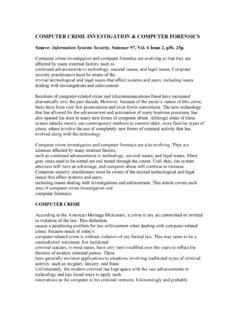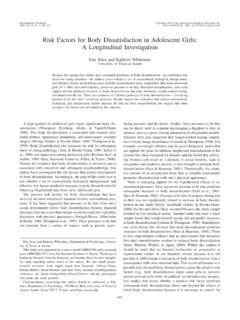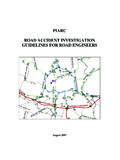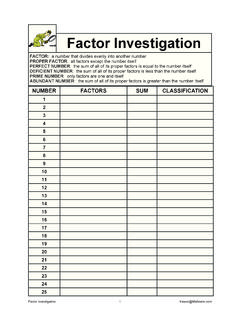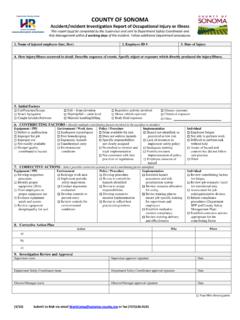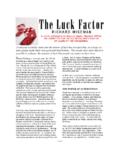Transcription of Using Incident Investigation Tools Proactively for ...
1 _____. Using Incident Investigation Tools Proactively for Incident Prevention Joanne De Landre, Gerry Gibb and Nicole Walters Safety Wise Solutions Pty Ltd Our Investigation and correction activities tend to be based on the amount of damage and injury which is random. We don't really have prevention programs; we have accident correction programs.. Richard Wood (1997). Aviation Safety Programs A Management Handbook. INTRODUCTION. Can simply correcting the deficiencies found through Incident investigations reduce error? Modern safety theory would suggest that relying on correcting deficiencies found through Incident Investigation as a means to reduce error is somewhat restrictive (Wiegmann &. Shappell 2003, Reason 2000, Wood 1997, Kleitz 1994). Significant factors leading to the Incident , and the subsequent actions necessary to prevent recurrence, do not always emerge from the physical evidence of the case alone.
2 Many incidents occur, not because they could not be prevented, but because the organisation did not appreciate the gaps in their safety systems, nor learn from, or retain the lessons from past incidents within or outside their organisation. The future direction for Incident prevention lies in Using Investigation methodologies as a tool that both integrates and compliments pre-existing processes such as risk management and audit. Using investigative Tools to identify and resolve the precursors to error and learning from past incidents can assist organisations to gain an appreciation of the strengths and limitations of their safety systems and reduce errors that lead to incidents. This paper will focus on the benefit of Using an Investigation framework Proactively to manage exposure and risks across organisations, then apply one such framework the Incident Cause Analysis Method (ICAM) to review an aviation accident and judge if proactive application of the framework may have identified the precursors, effectively preventing the adverse outcome.
3 Investigation Tools / FRAMEWORKS. The principle objective of Incident Investigation is to prevent recurrence, reduce risk and advance health and safety performance. It is not the purpose of this activity to apportion blame or liability. The use of established Investigation methodologies guide the Investigation team in following a structured, logical path during the course of an Investigation . Investigation methodologies provide guidance in gathering investigative data and a framework for organising and analysing the data. _____. ~ ANZSASI 2006 : De Landre, Gibb and Walters ~. Page 1 of 12. _____. Modern Investigation methodologies not only identify how an Incident occurred, but also identify why it occurred. Most importantly, corrective actions and key learnings arise from the Investigation aimed at preventing similar incidents from occurring again.
4 However, the effectiveness of corrective actions and key learnings in reducing error is clearly an area which needs to be improved upon, evidenced by repeat incidents seen through-out many industries. IMPROVING SAFETY AT AN ORGANISATIONAL LEVEL. Standard Investigation methodologies examine the physical evidence at an Incident site, the defences that failed to prevent or mitigate the Incident , the actions of people involved, the conditions that existed and the pertinent organisational factors. While this is usually effective at determining why a particular accident occurred, the Investigation methodology is not focused on, and therefore is not very effective at, making organisations safer. In order to improve safety at an organisational level and identify and reduce the precursors to error, a more holistic tool is required which examines the full range of organisational elements from a proactive stance.
5 While a number of Tools can be used for this purpose, this paper will focus on the Incident Cause Analysis Method. Incident CAUSE ANALYSIS METHOD (ICAM). The principles of the Incident Cause Analysis Method (ICAM), stem from the work of organisational psychologist and human error expert, Professor James Reason and his modelling of organisational accidents. Reason and his colleagues from the University of Manchester in the United Kingdom, developed a conceptual and theoretical approach to the safety of large, complex, socio-technical systems, of which aviation and mining are excellent examples. Reason defines organisational accidents as those in which latent conditions (arising mainly from management decisions, practices or cultural influences), combine adversely with local triggering conditions (weather, location etc.)
6 And with active failures (errors and/or procedural violations) committed by individuals or teams at the front line or "sharp end" of an organisation, to produce an accident (Reason, 1990; 1997). A fundamental concept of ICAM is acceptance of the inevitability of human error. Human factors research and operational experience, has shown that human error is a normal characteristic of human behaviour, and although it can be reduced, it cannot be completely eliminated (Helmreich & Merritt, 2000). ICAM is designed to ensure that the Investigation is not restricted to the errors and violations of operational personnel. It identifies the local factors that contributed to the Incident and the latent hazards within the system and the organisation (Gibb & De Landre, 2002). Through the analysis of this information, ICAM.
7 Provides the ability to identify what really went wrong and to make recommendations on what needs to be done to prevent recurrence. It is directed towards building error-tolerant defences against future incidents. SPECIFIC OBJECTIVES OF ICAM. The specific objectives of investigations Using ICAM are: 1. To establish all the relevant and material facts surrounding the event. 2. To ensure the Investigation is not restricted to the errors and violations of operational personnel. _____. ~ ANZSASI 2006 : De Landre, Gibb and Walters ~. Page 2 of 12. _____. 3. To identify underlying or latent causes of the event. 4. To review the adequacy of existing controls and procedures. 5. To recommend corrective actions which when applied can: - reduce risk, - prevent recurrence;. - and by default, improve operational efficiency.
8 6. Detect developing trends that can be analysed to identify specific or recurring problems. 7. To ensure that it is not the purpose of the Investigation to apportion blame or liability. Where a criminal act or an act of willful negligence is discovered, the information will be passed to the appropriate authority. 8. To meet relevant statutory requirements for Incident Investigation and reporting. APPLYING ICAM. ICAM is an analysis tool that sorts the findings of an Investigation into a structured framework. An adaptation of the Reason Model with the ICAM terminology is shown at Figure 1 below: Figure 1. ICAM Model of Accident Causation The ICAM model organises occurrence causal factors into four elements which are briefly explained on the following page: _____. ~ ANZSASI 2006 : De Landre, Gibb and Walters ~.
9 Page 3 of 12. _____. Absent / Failed Defences These contributing factors result from inadequate or absent defences that failed to detect and protect the system against technical and human failures. These are the control measures which did not prevent the Incident or limit its consequences. Individual / Team Actions These are the errors or violations that led directly to the Incident and are typically associated with personnel having direct contact with the equipment, such as operators or maintenance personnel. Task / Environmental Conditions These are the conditions in existence immediately prior to, or at the time of the Incident that directly influence human and equipment performance in the workplace. These are the circumstances under which the errors and violations took place and can be embedded in task demands, the work environment, individual capabilities and human factors.
10 Organisational Factors These are the underlying organisational factors that produce the conditions that affect performance in the workplace. They may lie dormant or undetected for a long time within an organisation and only become apparent when they combine with other contributing factors that led to the Incident . ICAM classifies the organisational factors into 14. Organisational Factor Types (OFT's) as seen in Table 1 below: Table 1. ICAM Organisational Factor Types HW Hardware TR Training OR Organisation CO Communication IG Incompatible Goals PR Procedures MM Maintenance Management DE Design RM Risk Management MC Management of Change CM Contractor Management OC Organisational Culture RI Regulatory Influence OL Organisational Learning _____. ~ ANZSASI 2006 : De Landre, Gibb and Walters ~. Page 4 of 12. _____.



